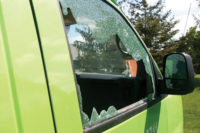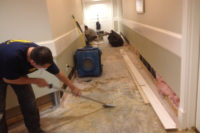Routine Mold Job Uncovers Hidden Asbestos Hazard: A Case Study
Those of us that have spent any amount of time in the restoration and remediation industry understand that asbestos is all around us






It was June 2012 when I got the call no project manager in the restoration and remediation industry wants to receive. It was the type of call that immediately changes the course of your day and causes a sickly feeling in the bottom of your stomach. It was the shakiness in my lead technician’s voice that told me something went terribly wrong before he even had the chance to finish his first sentence. The call, as I was about to learn, was to tell me that we had accidently disturbed asbestos during a routine mold remediation project for a high-valued client.
Those of us that have spent any amount of time in the restoration and remediation industry understand that asbestos is all around us. It can be found in ceiling tiles, flooring tiles, pipe insulation, wall insulation, roofing shingles and in just about every other type of building material found in homes and commercial buildings. Time spent in the field allows good project managers to get familiar with the dangers and warning signs, but even with training and experience, accidents can still happen.
The project started like any other. The call came in from a wealthy client who owned several homes in the Detroit metropolitan area and whom we had worked for in the past on his other properties. He was in need of some minor mold remediation to a recently renovated farm house that was built in the early 1900’s. New floor coverings, electrical, plumbing, insulation and windows were all part of the recent updating of the home. It was absolutely stunning in appearance, as the old fashioned aesthetics were preserved to maintain the antique and rustic look.
The mold contamination was caused due to a leaking roof. To that point in time, the home had not been occupied by our client and, as a result, the leak went unnoticed. It was located at the center of the ceiling of an upstairs office and consisted of a 100 square-foot area. The initial work scope was to hang containments and establish negative air, remove affected plaster ceiling, remove affected insulation, HEPA vacuum/damp wipe contaminated areas and abrasively remove mold contamination off of any structural materials.
A lead test was first performed, finding that the base layers of paint on the ceiling tested positive. This didn’t change the work scope much (besides posting necessary signage and distributing literature) as mold remediation typically covers above and beyond lead-based paint renovation requirements.
The next step was to determine if asbestos was present in the work area. I am not an AHERA Certified Asbestos Building Inspector or Project Designer, nor does our company provide these services, but we have been through many asbestos awareness classes and feel competent to realize when there is a potential issue. Knowing that we were going to be removing a portion of the plaster ceiling on the second floor, it was obvious that the attic insulation was the most likely place asbestos would be encountered. No other areas of the home were going to be disturbed to the extent where asbestos would be a serious concern, and I had been shown negative test results of the plaster itself.
I was informed by the homeowner that all asbestos insulation was removed from the attic prior to the home purchase one year prior by a qualified contractor. To be extra certain regarding the insulation and to ensure there was no other unforeseen circumstances above, I found the access in an adjacent bedroom and climbed into the attic, where I could see that the insulation was a blown-in fiberglass that was at an adequate depth for our local construction code throughout the entire attic. To be extra certain, I dug down to the underlying plaster ceiling to ensure that there wasn’t a layer of asbestos that was being hidden by the new blown in fiberglass. There wasn’t, and I left the attic without crawling to the area in need of remediation, which was about 40 feet over from the access point.
Mold remediation began the next week, and I sent one of our best and competent crews to the site to begin the project. The work was scheduled only to take one day, and since the paperwork had been signed and the home was on a lock box, I felt that I didn’t need to revisit the site with our crew since the job scope was simple and easy to explain from my office. I provided my two-man crew with a written scope of work and clearly explained how to hang the containments both in the attic space and in the office in which remediation was to take place.
At about 11 a.m. that morning I received the call. Our longtime remediation crew chief, Brian Karwowski, informed me that after removing the ceiling in the job scope, there was “pebble like” substance all over the floor within the containment zone amongst the fiberglass insulation. He too had been through many asbestos awareness classes and knew that there was a likely chance that the material found was in fact asbestos. My immediate instructions were for him and his crew associate to doff their PPE in the established decontamination chamber and leave the structure immediately.
I drove to the site as fast as I could with thoughts racing through my head. How could I have missed this? What health risks do our employees now face? Will our client be upset that the scope of work has now drastically changed?
Upon my arrival, Brian and Mike Gaunt were standing next to their van each with a distraught look on their face. We proceeded into the home together to better get a grasp on the situation. Knowing that cross contamination was a potential concern, I opened the containment briefly to get my own eyes on the questionable material. It looked just as Brian described, and resembled gravel on the side of a roadway. Taking no chances, I sent Brian and Mike home to immediately shower and told them to remove as much clothing as they could before they entered their vehicles.
I have been in this industry long enough to know that what looks like asbestos sometimes isn’t, and what doesn’t look like asbestos sometimes is. Before I called my client to inform him of the current situation, I figured it would be in everyone’s interest to place a call to our asbestos abatement vendor to have the proper testing done. They were on site within the hour and collected samples for rush testing to be completed.
Unfortunately for all parties involved, the testing came back positive for Tremolite asbestos in the insulation (2%). However, to my surprise and relief, the exposure was considered incredibly minimal as the techs were in proper coveralls and wearing full-face respirators with 2097 particulate filters. Furthermore, as both the living space and attic were properly contained and under negative air to IICRC S520 standards, cross contamination to the home was also minimal. It was likely limited to our crew walking from the work area to the front door without having the necessary shower stop required in asbestos abatement.
At this point in time, we pulled off the jobsite and allow the abatement team to complete the asbestos abatement and mold remediation. Amazingly, it was eventually found that only about half of the asbestos insulation had been removed in the original remediation scope completed before our customer purchased the home. The homeowner was willing to pay for full and proper asbestos remediation in the attic, and to this day is debating on whether or not to pursue legal action against the prior owner and abatement company.
At the end of the day, all of us involved in the project learned some valuable lessons. Several do’s and don’ts were able to be taken away from the situation:
Do:
- Perform all work to industry guidelines. In this case, proper negative air and containments for mold remediation indirectly contained the released asbestos.
- Keep a close working relationship with vendors. You never know when they can help bail you out of a bad situation.
- Be honest with all involved parties when things go awry. It helps build credibility and keeps customers and employees happy.
Don’t
- Rely on a homeowner to tell you that proper remediation has already taken place. Find out for yourself.
- Assume that underlying conditions can’t exist and differ throughout a structure in different areas. Inspect everything thoroughly yourself or subcontract it to a qualified party.
I would never look back at this incident and consider it a success, but at the end of the day I can feel good about saying that our employees were not exposed to a significant hazard and that no property was destroyed. It was a scary situation that reminded me of how difficult this industry can be at times. When we think we have all avenues covered, we are sometimes abruptly reminded that we don’t. Luckily for me and our crew, we were able to leave the situation relatively unharmed with lessons learned for the next restoration and remediation project.
Looking for a reprint of this article?
From high-res PDFs to custom plaques, order your copy today!











